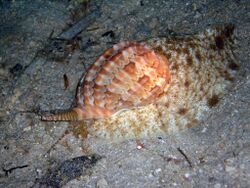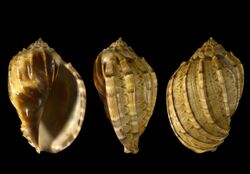Biology:Harpa major
From HandWiki
Short description: Species of gastropod
| Harpa major | |
|---|---|

| |
| A live individual of Harpa major | |
| Scientific classification | |
| Domain: | Eukaryota |
| Kingdom: | Animalia |
| Phylum: | Mollusca |
| Class: | Gastropoda |
| Subclass: | Caenogastropoda |
| Order: | Neogastropoda |
| Family: | Harpidae |
| Genus: | Harpa |
| Species: | H. major
|
| Binomial name | |
| Harpa major Röding, 1798
| |
| Synonyms[1] | |
| |
Harpa major, common name large harp,[1] or major harp,[2] is a species of large predatory sea snail, a marine gastropod mollusks in the family Harpidae, the harp snails and their allies.[1]
Description
The size of the shell varies between 60 mm and 130 mm . The average adult reaches 3 1/2 inches and the shells have an ovate body with a heavily calloused spire. The columella, or the lower portion of the inside coil, has dark brown coloring.[2]
It has a long siphon, a large mouth and a very large foot in proportion to its shell, which it uses to hunt its prey. A voracious nocturnal predator of benthic crustaceans on sandy bottoms, it can prey on crabs as large as itself.
Distribution
This marine species occurs off East Africa, Tanzania, Mozambique, the Mascarene Basin; off Hawaii
References
- Walls, J.G. (1980). Conchs, tibias and harps. A survey of the molluscan families Strombidae and Harpidae. T.F.H. Publications Ltd, Hong Kong.
External links
- Gastropods.com info, shell images
- Ladd, H.S. (1977). Cenozoic fossil mollusks from western Pacific islands; Gastropods (Eratoidae through Harpidae). U.S. Geological Survey Professional Paper. 533: i–iv, 1–84, pls 1–23
 This article incorporates text from this source, which is in the public domain.
This article incorporates text from this source, which is in the public domain.
Wikidata ☰ Q1056464 entry
 |


